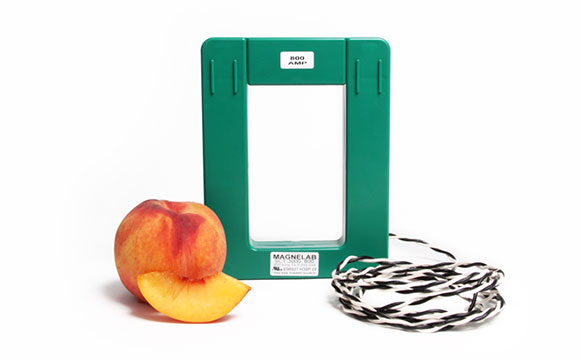How to Determine Core Size in Current Transformers
Ever wonder how to determine core size in current transformers? The following article by Eric Christensen and George Langer examines the factors related to current transformer cores. Be sure to contact Magnelab at 303-772-9100 for all your current transformer needs.
To determine the correct core for a current transformer (CT) you must first have an understanding of the basic operation. Current transformers (CT’s) operate with the same basic principles of standard transformers with a few differences in the design stages. The “primary” winding is generally considered a one turn winding consisting of the conductor passing one time through the center of the transformer. The “secondary” is the winding on the core consisting of “N” turns, therefore the ratio becomes 1:N, which determines the output current of the CT.

Output Current and Flux Level
The output current will cause a voltage to develop across the winding proportional to the winding resistance. The output current also must be burdened to create a specified voltage for measurement purposes. These voltages, along with the cross section of the core and the frequency of the signal determine the flux level in the core. This is opposite a standard transformer where the primary winding determines the flux levels in the core. The flux level is calculated using the following basic transformer formula:
B = (VT *108)/(4.44 * f * N * Ac * K)
Where: B = Flux density in Gauss
VT = Voltage across the winding + Voltage at the burden
F = frequency of the current
N = Number of turns (In a CT this is the secondary)
Ac = Cross section of the core in cm2
K = Stacking factor (SF) (see core information charts)
Wire Resistance and Size
When selecting a toroid core for current transformers there are many parameters to consider. For a fast response and an accurate output keep the winding resistance low while making the inductance of the secondary winding high. This can begin with the size of the core. It must be large enough to hold the winding while leaving enough room through the middle for the conductor you are measuring. Generally, the larger the core, the larger wire you can use for the winding, which lowers the resistance of the winding.
The selection of the core material to be used can be a little more difficult. Materials range from grain-oriented silicon steel to high permeability ferrites. Given the same core cross section, there are a few points to consider when selecting the core materials:
- Silicon steel cores have a low initial permeability but have a high flux saturation level for a higher VA rating
- Nickle alloy cores have a better initial permeability, but a lower flux saturation level so the VA rating is lower
- Ferrite cores have high permeability for fast response, but they have low flux saturation levels for the lowest VA rating
Other than ensuring correct core size and secondary wire size for good accuracy and to avoid overheating, burdened current transformers are fairly safe devices that should not pose a safety hazard. In general, the larger the CT the better accuracy and response you can achieve and the biggest hazard you may face is from dropping it on your foot.
Contact Information
To contact the author, Eric Christensen with questions about this blog article, or to order custom Magnelab products, email him at echristensen@magnelab.com or call him at 303-772-9100 extension 126.


B = (VT *108)/(4.44 * f * N * Ac * K)
let say i have a 100/5Amp ratio ,input voltage 415volts on primary of CT ,
i am confused that what will be VT here and how much ?
also what should be flux density for a low voltage CT with 100/5AMP ?
also what will be stacking factor of core?
kindly explain ,thanx
Thank you for the information so far. I have difficulty measuring or calculating transformer core area. I want to build a 2000va transformer from a 2000va stabilizer transformer. How will I determine the core area of this transformer?. If this transformer would be a good match for what I intend to build, what sizes and number of turns of wire will i apply here?. Thanks
The VT of a current transformer is determined by the voltage on the output instead of the voltage on the primary. If you have a 5 amp output you will need to determine the load used on the secondary circuit to determine the voltage (V). The frequency of the primary signal determines the rate of change in time (T). These are also the factors used when determining the core cross section needed.